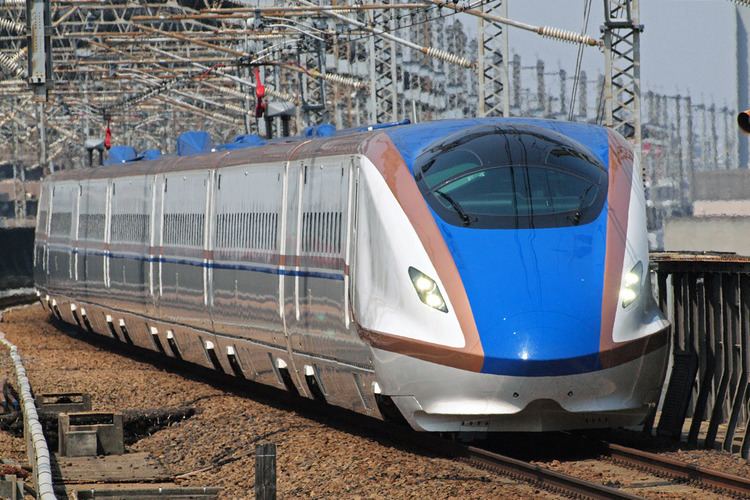Locale Japan Former operator(s) JNR | Status Operational Current operator(s) JR East | |
 | ||
First service 1 March 1961 (Semi-express)1 October 1997 (Shinkansen) | ||
The Asama (あさま) is a high-speed Shinkansen train service operated by East Japan Railway Company (JR East) on the Nagano Shinkansen in Japan. The shinkansen service was introduced in October 1997, but the name was first used for a semi-express service operated by Japanese National Railways (JNR) in 1961. "Asama" is the name of an active volcano (Mount Asama) near Karuizawa, on the boundary between Gunma and Nagano Prefecture.
Contents
Operations
All 16 Asama services stopped at Tokyo, Ueno, Ōmiya, Takasaki, Karuizawa, Sakudaira, Ueda, and Nagano. 11 of them made an additional stop at Kumagaya, Honjo-Waseda, and Annaka-Haruna.
Train formations
Asama services are operated using 8-car E2 series or 12-car E7 series or W7 series trainsets formed as shown below, with car 1 at the Tokyo end.
E2 series
In E2 series sets, car 7 is a "Green" (first class) car. All cars are no-smoking.
E7/W7 series
In E7 and W7 series sets, car 11 is a "Green" car, and car 12 is a "Gran Class" car with 2+1 seating. Unlike on Tohoku Shinkansen Hayabusa services, however, a dedicated attendant service is not provided in Gran Class cars on Asama services. All cars are no-smoking.
Rolling stock
Services were initially operated using a dedicated fleet of fourteen 8-car E2 series "N" sets based at Nagano Shinkansen Depot. Trains are designed to maintain speeds of 260 km/h (160 mph) on the 30 km continuous gradient of 30‰ between Takasaki and Karuizawa.
New E7 series 12-car sets, also based at Nagano Depot, were introduced on Asama services from the start of the revised timetable on 15 March 2014. These trains include "Gran Class" seating arranged 2+1 abreast. E7 series trainsets were initially used on seven return services daily, with a further four return workings added from 19 April 2014.
JR West W7 series 12-car sets, based at Hakusan Depot, were introduced from the start of the revised timetable on 14 March 2015.
Previously used
Pre-shinkansen
Semi-express Asama
The name Asama was first introduced on 1 March 1961 for semi-express (準急, junkyū) services operating between Nagano and Niigata. This service operated until 30 November 1962, after which the train was renamed Akakura (赤倉). From 1 December 1962, the name was used for the semi-express services operating between Ueno in Tokyo and Nagano on the Shinetsu Line. This service continued until 30 September 1963, after which the train was renamed Maruike (丸池).
Limited express Asama
After a gap of three years, the name Asama was re-introduced from 1 October 1966 on the Limited express services operating between Ueno and Nagano or Naoetsu. By the late 1990s, there were 29 workings daily in each direction, formed of 9- or 11-car 189 series EMU formations. During the busy summer periods, a second Green car was sometimes added to increase formations to 12 cars.
The typical 11-car 189 series formation in 1995 was as shown below, with car 1 at the Ueno end.
Shinkansen Asama
From 1 October 1997, the name Asama was used for the services on the newly opened Nagano Shinkansen (absorbed into the Hokuriku Shinkansen from 2015), operating between Tokyo and Nagano.
During the 1998 Winter Olympics in February 1998, additional services were provided using one specially modified 200 series train (set F80), limited to a maximum speed of 210 km/h. Four E4 series double-decker "Max" trains (sets P51/52 and P81/82) were also specially built for seasonal use on the Nagano Shinkansen as Max Asama services, but only two (sets P81 and P82) are capable of travelling as far as Nagano because the line west of Karuizawa runs on a 60 Hz power supply, unlike the rest of the line that runs on a 50 Hz power supply.
From the start of the revised timetable on 10 December 2005, Asama services were made entirely no-smoking.
From the start of the revised timetable on 15 March 2014, new E7 series 12-car trainsets were introduced on Asama services. Initially used on seven return services daily, this number was increased to eleven return services daily from 19 April 2014.
Following the opening of the Hokuriku Shinkansen extension beyond Nagano to Kanazawa in 2015, the Asama name continued to be used for those services operating between Tokyo and Nagano, with some services still operated by 8-car E2 series trains.
Future developments
From autumn 2015, one additional E7 series and one additional W7 series set are scheduled to be delivered, replacing all remaining E2 series trainsets on regularly scheduled Asama services.
